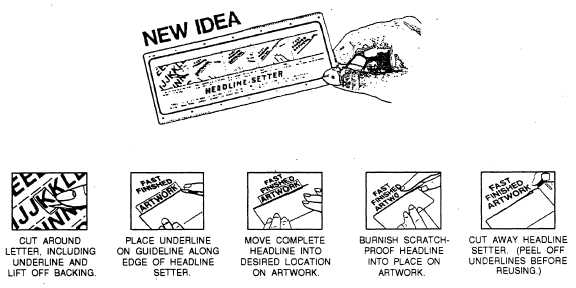A drafting board or table
A prepared paste-up (layout) sheet
A “T” square
A steel straightedge
Rulers
Rubber cement
Erasers
An india ink set
A cutting edge (X-acto knife or single-edge razor
blade)
Light blue (nonphoto blue) lead pencils
Scissors
A scale system to determine photo-reproduction
size
A printer’s rule
PHOTO-OFFSET ARTWORK
Artwork used in photo-offset printing includes line
art and halftone art. These are covered in the information
that follows.
Line Art
Line art (illustrations, rules, headlines, borders,
cartoons, crossword puzzles) and any other piece of
solid-color art to be included on the paste-up should be
enlarged or reduced to the exact size allotted for it on
the layout sheet. Type proofs must be carefully checked
to see that the lines of type are straight and the proofs
are pasted down square with the page. These proofs, as
well as art, must be handled with great care. The camera
records every error and every smudge of a careless
paste-up. For you to corrector eradicate such errors is
always costly and often impossible after the plates are
made.
Ordinarily, light-blue lines are used on the paste-ups
to indicate margins. Light blue will not show up in the
final photography. If necessary, you can draw in blue
lines yourself, but in a week-to-week operation, it is
much better to have them printed on standard layout
sheets. Check with your publisher for advice before
having your layout sheets printed on the various types
of margins that should be marked — and on the amount
of extra white space to leave for the publisher to work
with. Any lines you want to appear on the finished page
must be drawn or pasted in, in black, on the paste-up
sheet. Only lines in black india ink will reproduce
clearly on the offset plates.
There is also a number of alphabets printed on
sheets of transparent acetate or cellophane you may use
for headlines. These sheets have adhesive on one side
for pastedown purposes. When using them, you simply
cut out the letters with a knife and apply them to the
paste-up. Paste-up and pressure transfer alphabets are
known by their trade names, such as Formatt and Artype.
Figure 8-2 shows how paste-up lettering is prepared.
Another preferred method is to draw guidelines on the
Figure 8-2.—Paste-up lettering.
8-2

